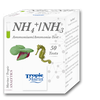Measuring range & accuracy
Measurement range: 0.02 - 3.0 mg/l (ppm)
Accuracy: 0.03 mg/l (ppm)
About ammonium and ammonia
Ammonium is the product of nitrogen mineralisation in which bonded nitrogen from food remains and excrement is converted to NH4+ by bacteria. Depending on the pH value, there is an equilibrium between ammonium ions NH4+ and ammonia NH3 in the water. If the pH value is less than 7, the largely harmless ammonium ions are dominant, while the presence of ammonia grows if the pH value is above 7. Ammonia is very dangerous as it impairs the breathing capability of living beings. It penetrates the cells easily, causing the pH value to rise and inhibiting vital functions. In a healthy and well-established tank, ammonium ions are quickly oxidised by nitrifying bacteria into nitrite and, in turn, into nitrate. If this chain of events is disrupted, the concentration of ammonium can suddenly rise. Therefore, the concentration of ammonium/ammonia should be tested, especially in new tanks.
In this test, the total concentration of ammonium / ammonia is measured. In freshwater applications, a total concentration of ammonium / ammonia of 0.1 mg/l (ppm) is normal under standard conditions, although an upper limit of 0.5 mg/l (ppm) should not be exceeded. In saltwater, the total concentration of ammonium / ammonia should be smaller than 0.05 mg/l (ppm). However, the crucial point in this respect is the pure concentration of ammonia, which is dependent on the overall situation defined by the temperature, the pH value and the total concentration of ammonium / ammonia in the aquarium. After a measurement has been taken, the ammonia concentration in the water can be determined.
Instructions for use
Determining the total concentration of ammonium/ammonia:
- Shake the dropper bottles before use!
- Rinse out the glass cuvette with tap water and then several times with aquarium water.
- Fill the glass cuvette with exactly 5 ml of aquarium water using the dosing syringe.
- Now add 10 drops of test reagent A to the water sample, close the glass cuvette using the stopper and briefly shake the solution.
- Then add 5 drops of test reagent B to the water sample, shake the glass cuvette briefly again and set it aside.
- Then add 5 drops of test reagent C to the sample, shake the glass cuvette briefly again and set it aside.
- After 6 minutes of development time, place the glass cuvette on the white inner circles of the colour card and compare it to thes urrounding colour field. To do this, look into the open cuvette from above. Move the sample on the colour card until the cuvette and the colour field match exactly. A slight cloudiness in the salt water sample will not affect the result of the test.
- Take note of the measured total concentration value under the relevant colour field. If the colours do not match exactly, an intermediate value can be estimated.
- Rinse out the glass cuvette and the measuring spoon thoroughly with tap water after the measurement process.







